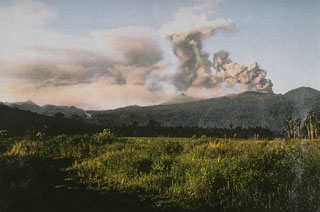Report on Dukono (Indonesia) — 2 March-8 March 2016
Smithsonian Institution / US Geological Survey
Weekly Volcanic Activity Report, 2 March-8 March 2016
Managing Editor: Sally Sennert.
Please cite this report as:
Global Volcanism Program, 2016. Report on Dukono (Indonesia) (Sennert, S, ed.). Weekly Volcanic Activity Report, 2 March-8 March 2016. Smithsonian Institution and US Geological Survey.
Dukono
Indonesia
1.6992°N, 127.8783°E; summit elev. 1273 m
All times are local (unless otherwise noted)
PVMBG reported that during 1 January-7 March white-and-gray plumes rose as high as 1.2 km above the rim of Dukono's Malupang Warirang crater, and were accompanied by roaring heard at the Dukono observation post 11 km away. The weather conditions were generally not windy so ash was deposited around the crater area. Seismicity fluctuated at high levels, but decreased overall compared the end of 2015. The Alert Level remained at 2 (on a scale of 1-4). Residents and tourists were advised not to approach the crater within a radius of 2 km.
Based on analyses of satellite imagery and wind data, and information from PVMBG, the Darwin VAAC reported that during 2-8 March ash plumes rose to altitudes of 1.8-2.4 km (6,000-8,000 ft) a.s.l. and drifted 25-195 km in multiple directions.
Geological Summary. The Dukono complex in northern Halmahera is on an edifice with a broad, low profile containing multiple peaks and overlapping craters. Almost continuous explosive eruptions, sometimes accompanied by lava flows, have occurred since 1933. During a major eruption in 1550 CE, a lava flow filled in the strait between Halmahera and the Gunung Mamuya cone, 10 km NE. Malupang Wariang, 1 km SW of the summit crater complex, contains a 700 x 570 m crater that has also had reported eruptions.
Sources: Pusat Vulkanologi dan Mitigasi Bencana Geologi (PVMBG, also known as CVGHM), Darwin Volcanic Ash Advisory Centre (VAAC)

